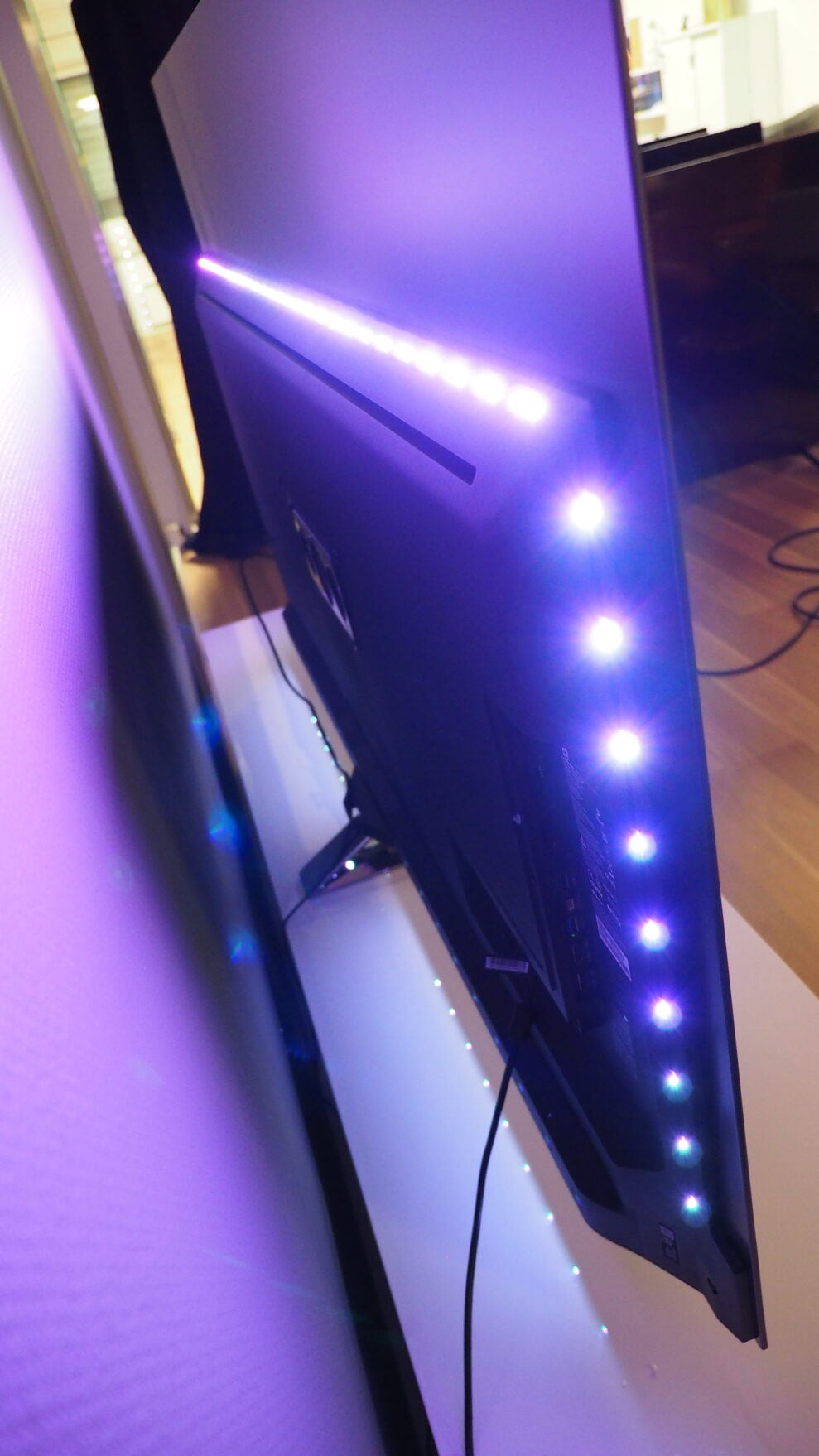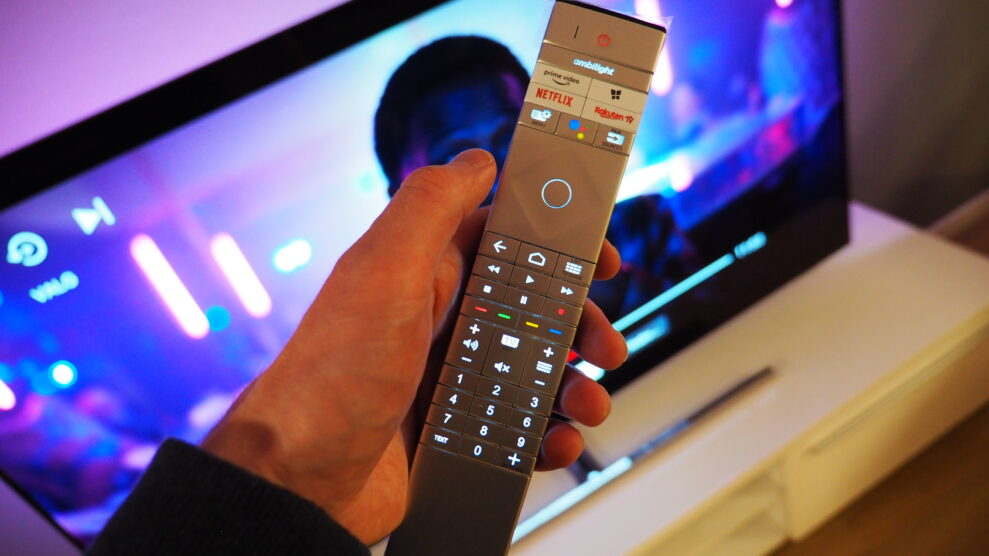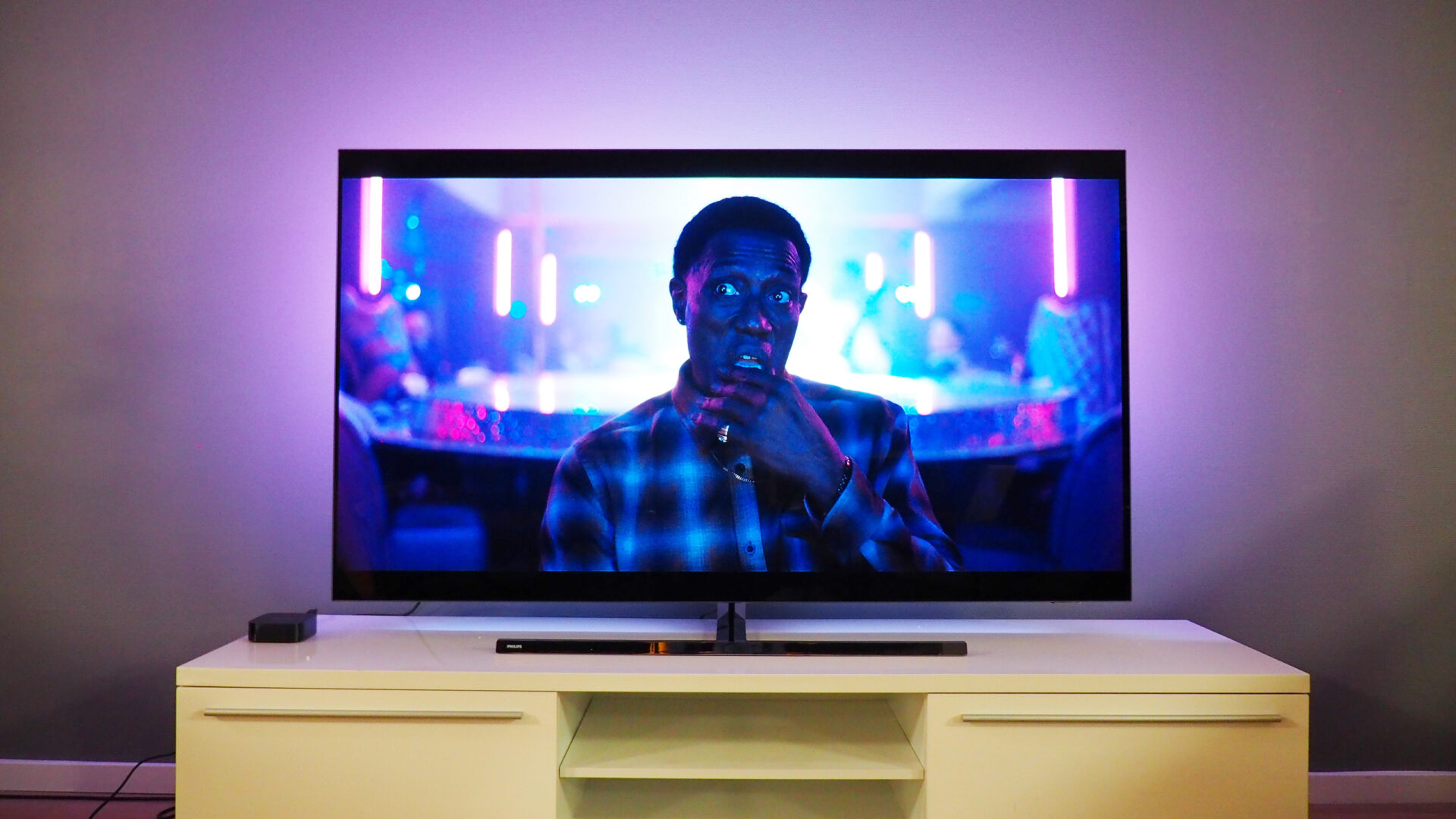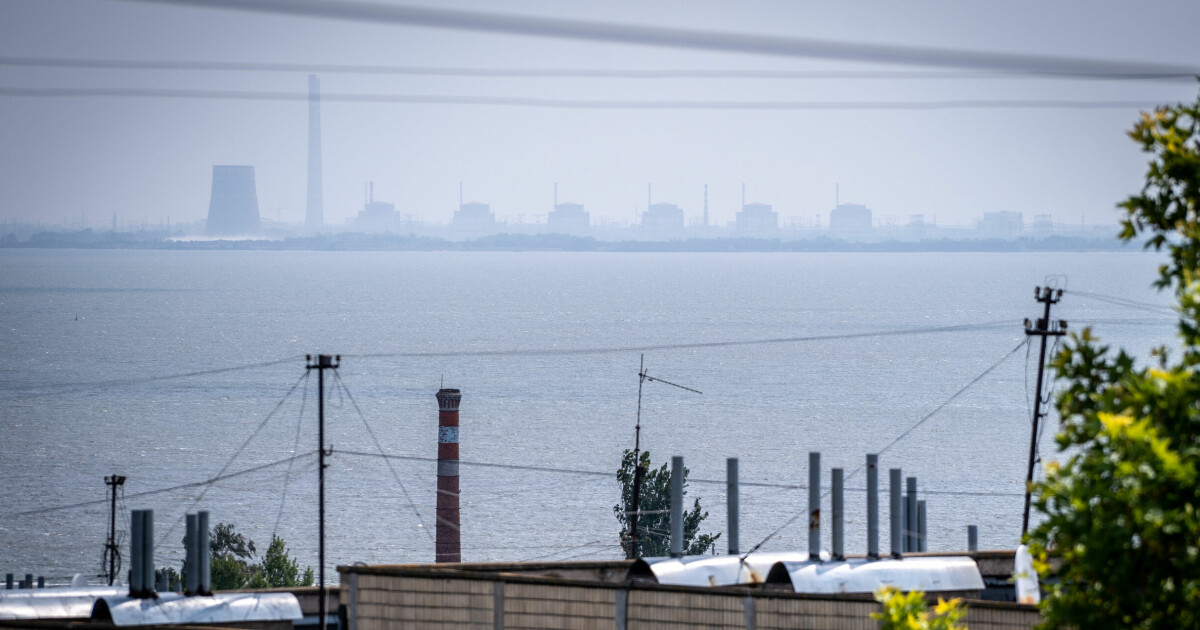Philips has a tradition of offering a great combination of picture and sound quality and modern design on their TV models: we’ve seen good examples of this in 2020, with many sleek and color TVs. 2021 models are now fully available in stores, and it looks like Philips is ready to continue down the same path, albeit with some obvious improvements.
newcomer OLED856 Among the most expensive OLED models from Philips this year. It is equipped with the 5th generation P5 video processor which promises clearer image processing. The OLED856 also has wide support for important video and audio formats, and has also received the much-anticipated HDMI 2.1 update. Plus, it now features Ambilight lights on four sides, which is another thing Philips is curious about!
Luxurious slim design
The Philips OLED856 has a sleek and elegant design appearance. The top of the screen is only a few millimeters thick, and it confirms that we are dealing with a high-end OLED panel. Down towards the center, the screen gets a little thicker to make room for the electronics and speakers.
The monitor has a new T-shaped base in reflective chrome: the stand itself is hinged, so you can turn the TV slightly to the right or left. It is convenient if you have several seating areas, the TV is in a corner or something. Philips also made it easy to have hidden wires under the foot. We recommend using it, otherwise the Ambilight could cast an ugly light on loose wires…
Noticeable! There is a lot in common between OLED856 and other Philips model, OLED806. These two models are more or less identical when it comes to features and image quality. The most significant differences lie in the design: while the OLED856 has a center-mounted base, the OLED806 has two small feet in silver. The OLED856 is only available in 55″ and 65″ screen sizes, while the OLED806 is also available in 48 and 77 versions.
Ambient light on the back
Ambilight is an original feature exclusive to Philips TVs. Using small LED lights, they can illuminate the back wall with colors that match the motion screen. It provides an evocative backlight, which brings some off-screen experience into the room. Ambilight can provide a charming picture experience, but it can also be more comfortable to rest your eyes.

We recently tested the LCD screen 65PUS8506There is no doubt that Ambilight gave a notable boost to empathy there. Compared to this, the OLED856 has an extra string of LEDs on the underside, thus it can spread light up, down, and to the sides of the screen. It gives a greater visual impact, especially if you also plan to mount the TV on the wall.
Ease of use and features
The Philips OLED856 comes with a new version of the Android user interface (10.0). This version is faster and more TV-friendly: Live TV channels and streaming services like Netflix, Disney + and HBO Max are all available quickly via the start menu – provided you have a subscription after that, of course. You will then automatically get recommended movies and series based on what you have watched before across different streaming services. Voice control via Google Assistant is also possible, via a microphone built into the remote control.
The OLED856 supports HDR Dolby Vision and HDR10+ formats. Each of these video standards contains a stream of dynamic metadata, allowing for greater variation in contrast. This way you can ensure that all compatible content (whether it comes from Netflix, Amazon or HBO Max, for example) can be viewed at its full potential. Philips, along with Panasonic and TCL, are the only ones who offer almost all HDR formats.

HDMI 2.1 on two inputs
Support for the latest HDMI 2.1 features shined through with its absence from the 2020 models, so Philips is glad they’ve got that now! Admittedly, only two of the four inputs, unlike the LG OLED65C1 that supports this in all four. Regardless: There’s now support for eARC (High Resolution Audio Return Channel) as well as coveted gaming features like VRR FreeSync and G-Sync. These continuously regulate the screen frequency (48-120Hz) to ensure a smoother gaming experience. The OLED856 also supports games in Dolby Vision HDR format at up to 60Hz.
The Philips monitor also has its own gaming mode with lower lag, which we measured at around 15ms – about half of last year’s model. OLED805. You can also choose to play with the Ambililight light activated: the light then changes quickly and dynamically into your gaming experience.
picture quality
This Philips model uses an OLED panel from the South Korean LG display, which is similar to what most other TV manufacturers use. As far as we can judge, this is a standard panel and not the newer “Evo” variant used on high-end models like the LG G1. On the other hand, video processors and other electronics from last year’s model have been updated.
The first impression is that the Philips monitor has all the well-known and beloved OLED qualities in order. We are immediately reminded of the importance of a proper black level: since all the small pixels in the panel can be turned on and off individually, there is no need for backlighting, and it contributes to great contrast. All colors and shades of gray can be painted on a completely black background, which gives the image a wonderful depth.
The question is whether the Philips OLED856 can offer something extra, beyond what we’ve already seen from other OLED competitors? The answer is yes, thanks in particular to two features: the P5 processor and Ambilight.
During the testing period, we compared the Philips monitor to the competition Sony A80JThere are undoubtedly more similarities than differences between these two. Both devices have an excellent black level and contrast, just as you’d expect from an OLED. However, we note that the Philips monitor has a slight advantage in the sharpness of movement.
Philips isn’t known for providing gunpowder when it comes to image processing, and the powerful P5 AI video processor emphasizes contrast and detail, and makes movements smoother, without feeling excessive.
The OLED856 also comes with several good image settings from the factory: here you can choose everything from Filmmaker’s Ultra-Neutral mode, where all unnecessary image processing is turned off, to Lively mode where the P5 AI processor gives a block on image processing. The Sony model doesn’t give us many options, and it seems to be aimed more at watching movies.
Philips also has an ace-shaped Ambilight case. The colored light on the back of the screen gives you a bolder experience for movies and series – not to mention music videos and nature shows. You won’t get a similar experience with Sony or other manufacturers, unless you turn to third-party solutions like the HDMI Sync Box and Ambient Light Strip, and even then they won’t be as good as the all-in-one solution offered by Philips.
The OLED856 looks really great on modern HDR video content: With Dolby Vision support, it can deliver the latest series from Netflix, Disney and HBO Max in the best quality. In addition, there is no doubt that Ambilight contributes to a more vivid image experience. Here from the True Story series on Netflix. (Photo: Udon Hag)
A little note about brightness
OLED displays are known for providing infinite black levels and virtually unlimited contrast. On the other hand, brightness is still somewhat limited, compared to the most powerful LCD screens. This can be a factor when choosing the right TV for your room and area of use.
A typical OLED display can deliver up to 700-800 nits on a small portion of the screen (10%), but can only handle 100-200 nits on the entire screen. By comparison, a bright LED-LCD can handle up to 1,000 nits in a full screen.
Like most OLED TVs, the Philips screen has great contrast in dark scenes, really glowing from bright HDR effects like sunlight, flames, and explosions. On the other hand, it may feel a bit tame when we watch diverse TV content in a fully lit room. Especially when compared to the latest MiniLED displays (Samsung QN95A, LG QNED99, etc.) you might miss a little extra brightness on some types of content. OLED, for example, is more suitable for the convenience of TV and movies in the evening, compared to winter sports during the day.
sound quality
The OLED856 has to do without the expensive B&W soundboard with Atmos surround sound, which you’ll find in its big brother OLED936. Here, instead, there are more moderate speakers, which are applied – but, fortunately, the integrated system sounds surprisingly good. The TV can run loud and clear, with good speech reproduction. Here there is also a separate speaker at the back that contributes to a beautiful and rich sound.
Many people may still prefer to connect to the separate sound router sooner or later. Therefore, it is good to know that the Philips monitor supports Dolby Atmos audio processing, and can output audio via the HDMI eARC output. We checked the sound with one JBL tape 50 multibeamThen it was confirmed that the Philips monitor transmits Dolby Atmos audio signals from built-in apps such as Netflix.
However, we had trouble extracting the same Atmos audio from external video sources: we tested with a file Apple TV 4K, which transmitted the correct Dolby Vision video signals to the TV, but for some reason the TV could not send Dolby Atmos / Dolby Digital + audio signals to the speakers. Even after a “deep dive” into the audio settings, we weren’t able to get Atmos audio out through the Apple TV and HDMI — despite the fact that the internal apps work just fine.
We also note that some Philips users have reported similar audio issues using the OLED856 / OLED806 with external video sources and audio systems. So we hope Philips can fix this issue with a firmware update soon!
conclusion
Philips OLED856 TV is an OLED TV with many great qualities. The design is cool with a dark chrome plated base that can also be flipped. The Android user interface ensures great usability, and the remote control has backlit buttons. Picture quality is impeccable, with great contrast and accurate colors as we’re used to on OLED – although perhaps best suited for watching TV in the evening, rather than in a lighted room. Philips also improves the picture experience with four-sided Ambilight colored light. Last but not least, the OLED856 has been updated with more HDMI features that make this TV more suitable for gaming than its predecessors. Definitely worth recommending!

“Web specialist. Lifelong zombie maven. Coffee ninja. Hipster-friendly analyst.”



